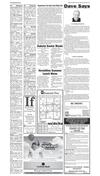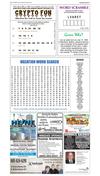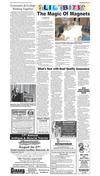9
Broadcaster Press 9
July 14, 2015 www.broadcasteronline.com
Economics & Ecology
Working Together
Categorized: Livestock, Agronomy, Healthy Families,
Health & Wellness, Community Development, Communities
BROOKINGS, S.D. - By returning their ranchland to presettlement condition, a South Dakota ranch family put nature
to work for them with incredible results.
“Oftentimes we hear that ecology and environment don’t
mix with economics, but the Mortenson’s prove you can
have both. Their ranch is beautiful, full of native habitat and
wildlife which provide hunting and other opportunities, but
it is also stocked with good quality cattle,” explains Carter
Johnson, Distinguished Professor of Ecology at South Dakota
State University who painstakingly documented the family’s
journey in a recently released online book; The Mortenson
Ranch Story: Balancing Environment and Economics.
“Ranching is a tough job if you have to do everything
yourself, but if you can get nature to work for you - like the
Mortensons have done - the results are beautiful and pay the
bills,” said Johnson, who met the family patriarch, Clarence
Mortenson in 1990 and began conducting research and documenting the family’s restoration progress.
“This story details Clarence’s conservation and management philosophy and how it has been implemented by three
generations of his family to restore the ranch’s environment
and economy that ultimately earned the Mortensons the coveted Aldo Leopold Conservation Award in 2011,” said Johnson
in the book’s Abstract.
Johnson explains that Clarence grew up in the early years
following the Dust Bowl. As a young boy, he learned from an
old homesteader how beautiful and productive the heavily eroded and barren landscape once had been. “Clarence
vowed that if and when he took over the ranch he would get it
back to its pre-settlement condition of thick grass, clear-water
streams, dense woody draws and abundant wildlife. But the
ranch was not to be a “preserve,” it had to provide a sustainable living for a large family,’” Johnson wrote.
He added. “In my 40 years of studying riparian woodlands
in many states, never have I met producers with more enthusiasm, dedication, and genuine interest in restoration and
conservation as the Mortensons.”
For five decades, the Mortensons have invited SDSU
students, faculty, researchers and SDSU Extension to not only
conduct research on their land, but to use it as an outdoor
classroom where other ranchers and landowners could see
firsthand how various restoration projects worked to enhance
the land for wildlife as well as cattle.
Johnson says that what makes all the research on the
Mortenson’s land unique is Clarence’s extensive knowledge of
the land’s history. “This book chronicles close to 100 years of
history. We probably know more about this ranch than almost
any other in the state,” Johnson said.
Along with scientific data and details on the Mortenson’s
restoration projects, the book contains historical information
as well as photos. “I sort of turned into their family’s biographer by accident. It was not an easy role because I’m not a biographer. But I did my best to pull together what we learned
during those 25 years and more,” said Johnson. “My overall
goal was to pull scientific as well as experiential information
together so that other ranchers can read, relate and implement projects to help them restore their own ranches.
Today the ranch is managed by Clarence’s son Todd and
his wife Deb, together with their sons Jack and Quinn.
“Each generation has done something different to improve
it. I still see areas that I can improve upon, and I want to be
sure that when I hand this over to my boys, it is as good as
I could do and, hopefully, it will continue with them,” said
Todd Mortenson, as quoted in the 2011 Leopold Conservation
Award Bulletin.
L I L’ BIT S
The Magic Of Magnets
BY SARAH WETZEL
For the Plain Talk
Kids at the Vermillion library had a
chance to explore and learn about the
properties of magnets Monday as part of
the Summer Reading Program.
This time, the activities were Magneto themed as kids learned why stuff
sticks.
First the kids were given magnets and
asked to observe their properties along
with thinking of other places they have
seen magnets.
“We have magnets at my house,” said
Connor, 4.
“They stick to the fridge,” observed
Henry, 7. “They stick through paper.”
The children were given a bag full of
objects to experiment with and see what
the magnets would stick to.
“This is plastic so it won’t stick,” said
Libby, 8. “Ooh, a coin and Nails.”
“I’ll test the things that do stick,
you test the things that don’t,” she said
handing a pile of objects she hypothesized would not stick to a partner.
In some cases, the kids guessed right.
“I’m guessing that this won’t stick,”
said Henry reaching for a fuzzy ball.
“Yup, it doesn’t.”
In other cases the kids were surprised.
“Most of the stuff doesn’t didn’t
stick,” Henry reported. “I was surprised
that the penny didn’t stick.”
Connor found items that stuck even
in the pile of items the kids expected not
to stick.
“It finally works!” He said holding up
his magnet with a pipe cleaner stuck
to it. “Let me try out the straw. No, it
doesn’t stick. I was surprised the button
didn’t stick.”
The discovery continued.
“Let’s try the other pipe cleaner,”
SARAH WETZEL/FOR THE PLAIN TALK
Kids at the Vermillion Public Library experimented and explored the
properties of magnets at Monday’s science activity.
Libby said. “I was surprised that the pipe
cleaner stuck.”
The children learned that though
magnets seem attracted to metal, only
Iron and Steel actually stick to magnets
which is why items like the penny did
not stick to their magnets.
Exploring the Kozak room of the
library, the kids found other things containing Iron and Steel.
“I’ll show you something that does
stick,” Libby said to Connor, showing
him a metal pole. “Mine also stuck to the
thing by the door.”
Next the kids explored magnetic
fields.
“It’s the part that makes things connect,” Henry explained.
“It’s kind of like static electricity,”
Libby added.
The kids used a paper clip attached
to a string to test how strong the magnetic field was on their magnets.
“It doesn’t go very far,” Henry observed.
Some doughnut-shaped magnets
were placed on a stick with similar poles
facing one another to show the kids that
like-poles repel each other.
“It feels like there’s a bubble,” Libby
observed.
In between learning all about magnets, kids will be kids.
“This would make a good lock pick,”
Libby said, bending a paper clip.
“I made a sword,” announced Henry.
“It’s tiny but it still hurts. Poke! Poke!”
“My controller broke,” Connor
lamented but quickly reshaped his makeshift weapon. “It’s a super shooter!”
What’s New with Beef Quality Assurance
BROOKINGS, S.D. - Beef
Quality Assurance (BQA)
and Dairy Animal Care and
Quality Assurance (DACQA),
also known as Dairy BQA,
focus on best management
practices for the day-to-day
husbandry practices used in
caring for cattle that provide
beef for family’s tables
across the United States and
abroad.
“The National BQA program continually works with
all sectors of the beef and
dairy industries to improve
the content, credibility and
the uniformity of standards
for raising food animals to
assure the quality of beef
products,” explained Heidi
Carroll, SDSU Extension Livestock Stewardship Associate.
Antibiotic stewardship
is a key component to both
BQA and DACQA programs.
This includes all medications or feed additive use. As
changes occur to FDA regulaJACKIE WILLIAMS/FOR THE PLAIN TALK tions, Carroll reminds cattle
Rylee Black, Rotary Youth Exchange Program was producers to maintain their
in Romania August 18, 2014 thru May 27, 2015 and cattle treatment records,
veterinary instructions and
was sponsored by the Vermillion Rotary.
drug inventory lists accordingly. “Records should be
maintained for two years.
Additionally, remember
to keep veterinarian’s prescriptions and VFDs with the
records,” Carroll said. “More
importantly, maintain a valid
veterinarian-client-patient
Don’s Dust
Control
relationship (VCPR) to be
able to acquire feed-grade
medications when situations
arise and have veterinary
input to continually improve
herd health plans.”
Feed yards & BQA
Feed yards are held to
high standards and often put
under the microscope in the
eyes of meat packers and
the public. Because of this,
Carroll explained that the
National BQA program continues to collaborate with
major packing companies
to create a more uniform
producer training program
on cattle handling instead
of multiple packer-specific
programs.
“All employees should
maintain a current BQA
certificate,” she said.
The BQA program strongly encourages feed yards to
complete a Feed yard Assessment every three years
and create written Standards
of Practice Protocols. Once
an assessment is complete a
feed yard qualifies to be included on the National BQA
list of certified feed yards.
“The National BQA list
of certified feed yards will
allow packers to verify feed
yard BQA certification before
purchasing cattle,” Carroll
explained.
She added that this assists packers in keeping their
commitments to consumers
about the well-being of the
cattle they either own or
purchase.
The database will solely
be accessed by national or
state BQA coordinators and
packers to ensure producer
confidentiality.
Dairies & DACQA
Dairy beef accounts
for 15 to 20 percent of the
United States’ beef production. The National BQA
program teamed up with the
dairy industry to provide a
collaborative effort to handle
producer training programs
and develop uniform resources on animal care and
handling.
Carroll explained that the
DACQA program will more
closely reflect the Farmers
Assuring Responsible Management (F.A.R.M.) standards that are required by
milk processors. “Since dairy
feedlots are not required to
participate in the F.A.R.M.
program, they should maintain DACQA or BQA certification,” Carroll said.
New training materials
will be available soon.
Become certified
The South Dakota Beef
Industry Council (SDBIC)
still requires cattlemen to
complete both levels of the
South Dakota Beef Quality
Assurance / Critical Management Plan (SD BQA/CMP)
program, the educational
training (Level 1) and the
veterinarian approved site
and treatment plan (Level 2),
to be considered a certified
producer.
“Feed yards should get
Romsdahl’s
• Horse Arenas
• Private Drives
• Unpaved Roads
• Elevator Access
• Free Estimates
605-491-2133
Repair & Remodel
Carpentry, Interior
& Exterior, Painting,
Refinishing, Drywall, &
Ceramic Tile
Free Estimates
17 Annual
Antique & Muscle Tractor
th
605-670-2161
in the habit of completing a
Feed yard Assessment on a
regular basis and updating
their files to have current
written Standards of Practice
Protocols, which is similar to
Level 2 requirements,” Carroll explained.
The SDBIC and SDSU
Extension are updating the
South Dakota materials appropriately and compiling
the National BQA resources
for producers.
2015
DAVID KRANZ
SCHOLARSHIPS
GIVEN
Two student journalists
have been awarded 2015 David Kranz-Argus Leader Media
Journalism Scholarships.
Heidi Kronaizl, a South
Dakota State University senior,
and Matthew Housiaux, an Augustana College senior, were
selected for the awards, which
recognize long-time journalist
and political columnist David
Kranz.
Kranz worked as a reporter, editor and columnist
at the Argus Leader and other
newspapers until his retirement in 2010.
Kronaizl is a Vermillion
resident. She has worked as a
reporter and news editor on
The Collegian and has served
as an intern at South Dakota
Public Broadcasting.
Housiaux is from Brookings and will be a senior this
fall at Augustana.
This is the first year that
two scholarship awards were
presented. The $1,500 scholarships are awarded for the
upcoming school year.
“We are thrilled that we are
able to award two scholarships this year,” said Maricarrol Kueter, chair of the David
Kranz-Argus Leader Media
Journalism Scholarship Committee. “Working with young
journalists was one of David’s
passions and being able to assist two students in his name
is gratifying.”
August 26-27th
Girard Auction Facilities, Wakonda, SD
CONSIGN TODAY! All types of vintage tractors excepted
in all conditions! Also quality implements, good tractor
parts & accessories, signs, cast iron antiques
(seats, windmill weights, ect.) and more.
100+ Tractors expected!
Call today with your list or email
girardauction@gmail.com with a list & photos.
Consignment Deadline for full color brochureMonday August 3rd! Toll Free: 1-866-531-6186
Why
GIRARD AUCTION
& LAND BROKERS, INC.
(605) 267-2421
Toll Free: 1-866-531-6186
Why
settle
GirardAuction.com
Why
GirardBid.com
settle for
Why
settle for
just a
slice …
When 100% of your
retail market
receives The
Broadcaster.
The Broadcaster is the
primary medium
successful
businesses
Why
settle for
just a slice
When 100% of your retail
market receives
The Broadcaster.
The Broadcaster is the
primary medium
successful
businesses
have used to reach their
customers for over 50 years.
Your Broadcaster carries
more advertising than all
other local media
combined. And, like our
customers,
Why settle
for
just a slice
When 100% of your retail
market receives
The Broadcaster.
The Broadcaster is the
primary medium
successful businesses
have used to reach their
customers for over 50 years.
Broadcaster
201 W. Cherry St.
624-4429











 Previous Page
Previous Page





